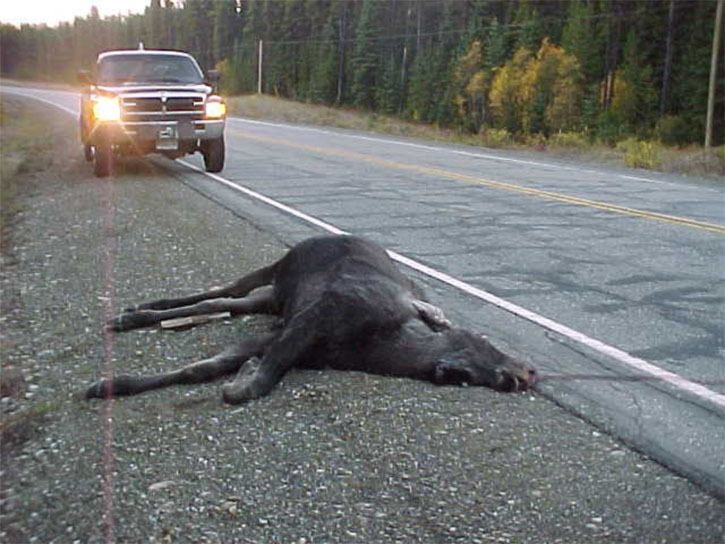The British Columbia Conservation Foundation estimates that 300 to 350 wildlife collisions occur in the Burns Lake area - within a 30 to 40 km radius - every year.
Of those collisions, about 36 per cent are moose, 45 per cent are deer and about seven per cent are bears.
This research was carried out by University of Northern British Columbia researchers Roy Rea and Shannon O’Keefe and the Wildlife Collision Working Group, based on ICBC data from 1996-2010.
According to the provincial government, there are approximately 6300 wildlife fatalities reported from vehicle collisions each year on numbered highways across the province.
However, for every carcass that is recovered, it is estimated that three more animals are hit and killed but not counted in official numbers. Gayle Hesse with the British Columbia Conservation Foundation explained that this includes animals that were hit on the road, but died elsewhere.
Therefore there are an additional 18,000 dead animals each year in B.C., bringing the total estimate to a staggering 25,200. Of those wildlife collisions, 80 per cent are deer, three per cent are bear and seven per cent are moose.
Hesse explained that moose collisions are less common in the southern parts of the province because there are less moose there.
“Down south they have more elk and deer collisions,” she explained.
Although there are several reasons that attract wildlife to the roads, Hesse says mineral or “muck” licks are an important factor.
Licks are wet, muddy seepage areas where below-ground mineral springs upwell to deposit materials collected by waters percolating through surrounding soils.
Hesse said these licks are very attractive to moose, typically in June and July, when moose seek supplemental sources of mineral elements and other material present in the mud and water of mineral deposits.
“When these licks are located in the road right-of-way, the risk of moose-vehicle collisions increases,” she said.
The moose population declined by 14 per cent in B.C. between 2011 and 2014, according to the provincial government. In the Bulkley Valley Lakes District, the moose population declined by 20 per cent from 2004 to 2011.
There has been a lot of debate about the reasons behind the decline. Hesse said she doesn’t believe that vehicle collisions have significantly contributed to the decline.
“I don’t think that’s the case,” she said. “Moose collisions have declined in the past few years, and it’s a reflection of the fact that there are less moose.”
The province does not monitor or keep track of statistics on railway-related wildlife mortality rates.
To swerve or not to swerve?
Encountering wildlife on the road can be a stressful experience, and many drivers may wonder how to properly react when it happens.
Do you know what to do when you encounter wildlife on the road? And what should you do after you hit an animal?
Gayle Hesse with the British Columbia Conservation Foundation says drivers shouldn’t swerve if they see a small animal on the road. It is sometimes recommended to hit small animals to avoid stopping abruptly, which could possibly cause an accident.
“Swerving is really dangerous,” she said. “You can lose control of the vehicle, you can go into the other lane, or you can go into the ditch.”
When it comes to moose, Hesse has a different advice: she says drivers should try to stop if they see a moose.
“Moose is a different story,” she said. “They are huge animals; their centre of gravity is very high because their legs are so long.”
“When you hit a moose, you knock the legs down from underneath it, and it [the animal] comes crashing down on the top of your car.”
Hesse also says that it’s important to aim for the back end of the animal.
“By the time you get to the back end of the animal, hopefully it’s moved on,” she explained. “If you aim for the head, it [the animal] is still going to be there [by the time you get near the location].”
When it comes to deer, Hesse said drivers should always assume that other deer might be following behind it.
“People forget to look behind to watch for animals coming behind it [the deer], so you might miss the first one and hit the second one,” said Hesse. “Always shift your focus off the first one to see if there are more [deer] coming along.”
Hesse said that if drivers hit an animal, the first thing they should do is pull to the side of the road to make sure that they are safe, and get their adrenaline under control. Then drivers should warn other drivers of the danger on the road.
“Drivers have a duty of care to other drivers,” she said. “If you hit an animal and it’s dead in the middle of the road, you have a legal responsibility to notify other drivers of that hazard.”
“You can’t just hit an animal and drive away,” she added. “You will be held legally responsible if there’s another collision that comes along.”
In addition, if a driver kills an animal, he or she is not allowed to remove the carcass.
“Animals belong to the Crown, so if you kill a deer, you can’t just put it in your trunk and take it home.”
Hesse adds that drivers should always anticipate that they are going to see animals on the road.
“I want people to drive expecting to see animals on the side of the road,” she said. “Don’t be surprised when they’re there; they preferentially choose to be there in lots of cases.”
According to the British Columbia Conservation Foundation, peak months for collisions in the Burns Lake area are December/January and June/July. Peak times of day for collisions are between 5 p.m. and 7 p.m.
Incidents involving wildlife should be reported to the B.C. Conservation Officer Service by calling 1-877-952-7277.
